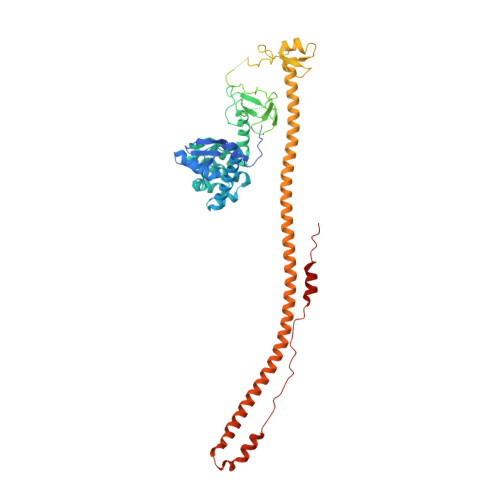Structure of KAP1 tripartite motif identifies molecular interfaces required for retroelement silencing.
Stoll, G.A., Oda, S.I., Chong, Z.S., Yu, M., McLaughlin, S.H., Modis, Y.(2019) Proc Natl Acad Sci U S A 116: 15042-15051
- PubMed: 31289231
- DOI: https://doi.org/10.1073/pnas.1901318116
- Primary Citation of Related Structures:
6QAJ - PubMed Abstract:
Transcription of transposable elements is tightly regulated to prevent genome damage. KRAB domain-containing zinc finger proteins (KRAB-ZFPs) and KRAB-associated protein 1 (KAP1/TRIM28) play a key role in regulating retrotransposons. KRAB-ZFPs recognize specific retrotransposon sequences and recruit KAP1, inducing the assembly of an epigenetic silencing complex, with chromatin remodeling activities that repress transcription of the targeted retrotransposon and adjacent genes. Our biophysical and structural data show that the tripartite motif (TRIM) of KAP1 forms antiparallel dimers, which further assemble into tetramers and higher-order oligomers in a concentration-dependent manner. Structure-based mutations in the B-box 1 domain prevent higher-order oligomerization without significant loss of retrotransposon silencing activity, indicating that, in contrast to other TRIM-family proteins, self-assembly is not essential for KAP1 function. The crystal structure of the KAP1 TRIM dimer identifies the KRAB domain binding site in the coiled-coil domain near the dyad. Mutations at this site abolished KRAB binding and transcriptional silencing activity of KAP1. This work identifies the interaction interfaces in the KAP1 TRIM responsible for self-association and KRAB binding and establishes their role in retrotransposon silencing.
- Molecular Immunity Unit, Department of Medicine, University of Cambridge, Medical Research Council Laboratory of Molecular Biology (MRC-LMB), CB2 0QH Cambridge, United Kingdom.
Organizational Affiliation:

















